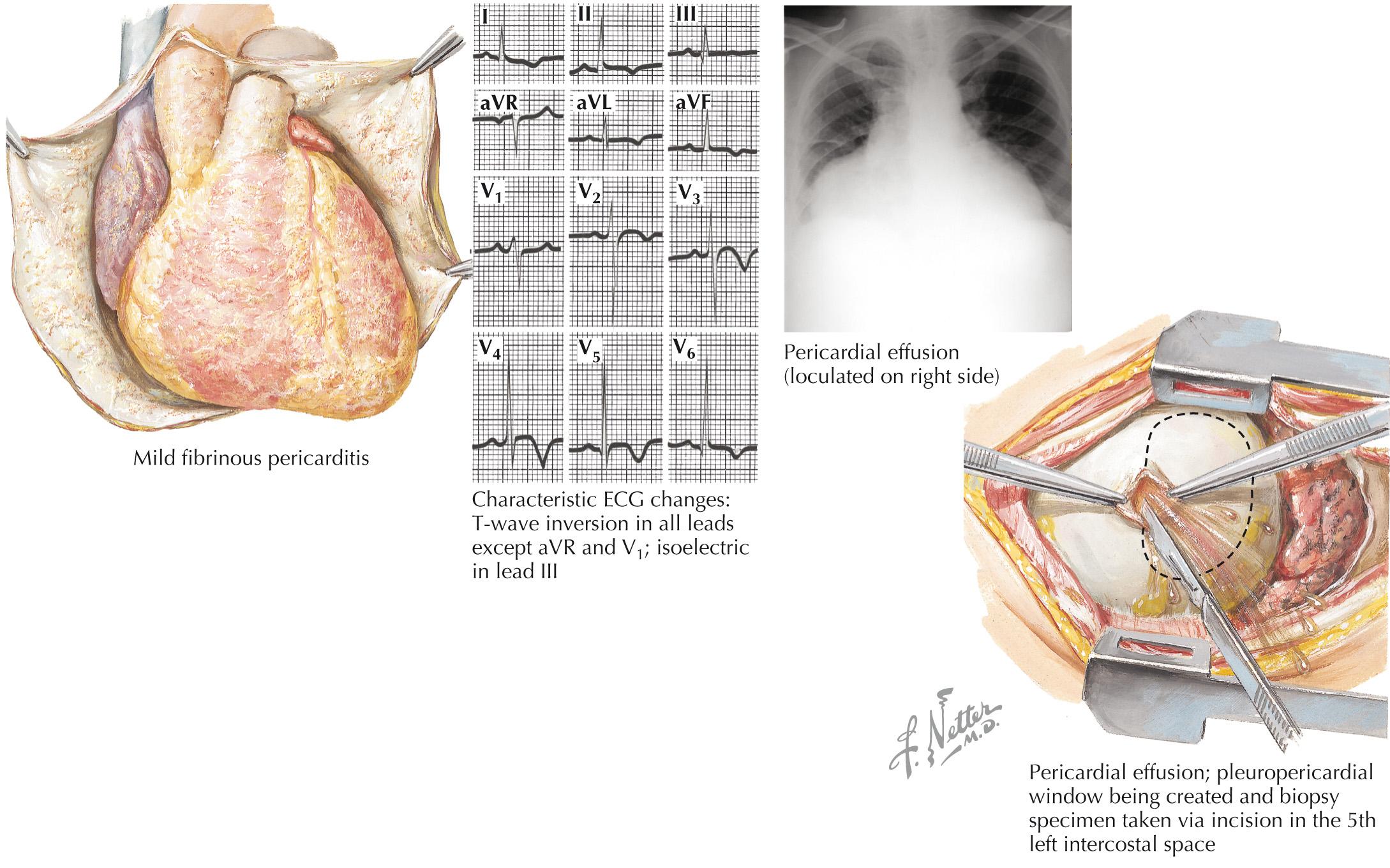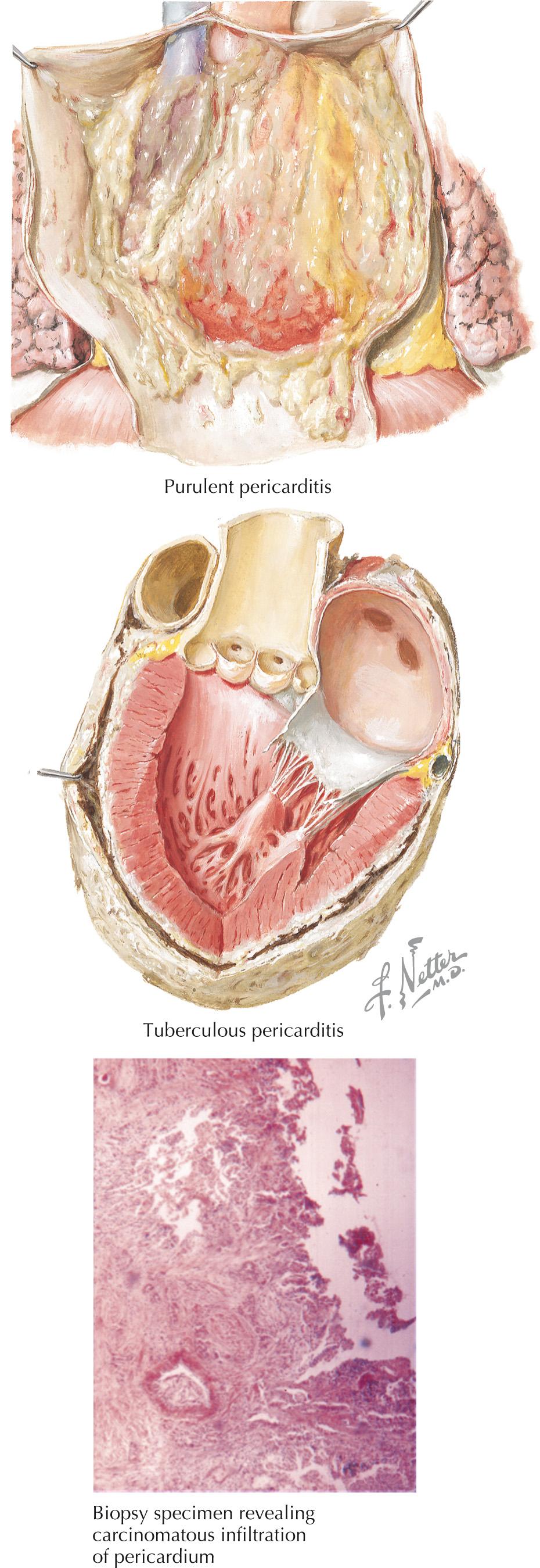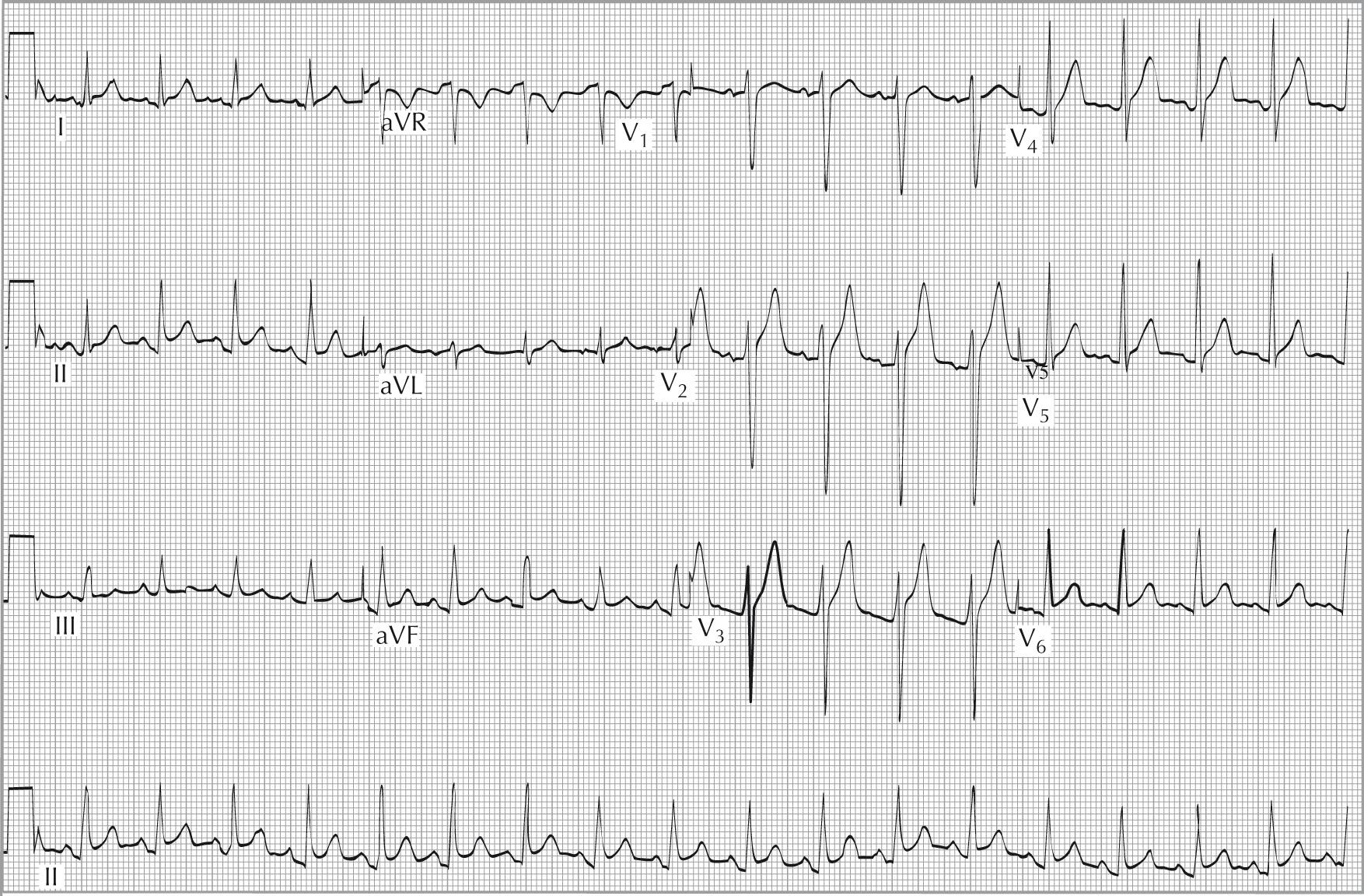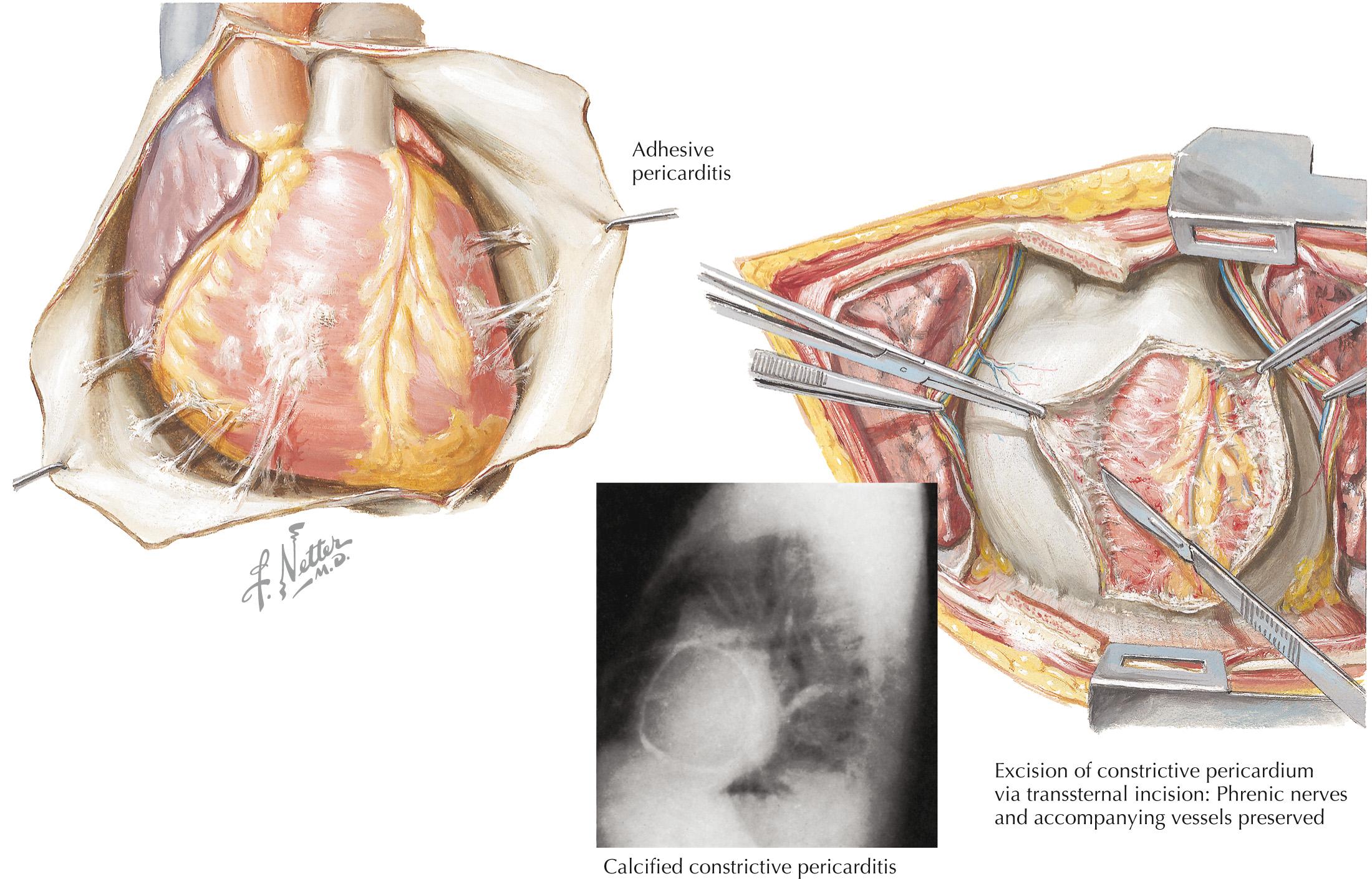Physical Address
304 North Cardinal St.
Dorchester Center, MA 02124
The pericardium is a two-layered sac that encircles the heart ( Fig. 56.1 ). The visceral pericardium is a mesothelial monolayer that adheres to the epicardium. It is reflected back on itself at the level of the great vessels, where it joins the parietal pericardium, which is the tough fibrous outer layer. Under normal conditions, a small amount of fluid (~5–50 mL) separates the two layers and decreases friction between them.
The normal pericardium serves three primary functions: fixing the heart within the mediastinum; limiting cardiac distention during sudden increases in intracardiac volume; and limiting the spread of infection from the adjacent lungs. However, the importance of these functions has been questioned because of the benign prognosis associated with congenital absence of the pericardium.
This chapter discusses the clinical features and treatment of four pathological conditions that involve the pericardium: acute pericarditis, chronic pericarditis, constrictive pericarditis, and pericardial effusions. The hemodynamic effects of pericardial pathology are discussed in Chapter 57 .
The most common presentation of a pericardial abnormality is acute pericarditis, which is inflammation of the pericardium ( Fig. 56.2 ). In general, this is a self-limited disease that is responsive to oral antiinflammatory medication. Acute pericarditis infrequently necessitates hospital admission. It is more common in men than in women and more common in adults than in children. The two most common causes of acute pericarditis in the United States are viral and idiopathic. Viruses that have been implicated in causing pericarditis include coxsackie virus B; echovirus; adenoviruses; influenza A and B viruses; enterovirus; mumps virus; Epstein-Barr virus; HIV; herpes simplex virus type 1; varicella-zoster virus; measles virus; parainfluenza virus type 2; respiratory syncytial virus; cytomegalovirus; and hepatitis viruses A, B, and C. Other causes include uremia, pericardiectomy associated with cardiac surgery, pulmonary embolism, collagen-vascular diseases, Dressler syndrome, malignancy, tuberculosis, fungus (e.g., histoplasmosis), parasites (e.g., amoeba), myxedema, radiation, acute rheumatic fever, and trauma ( Fig. 56.3 ).


The clinical presentation of pericarditis is most often dominated by chest pain, which is generally sharp, pleuritic, and positional in nature, increased by lying supine and improved by leaning forward. Symptoms may include dyspnea, palpitations, coughing, and fever, and the patient may have a history of a viral prodrome. On physical examination, a pericardial friction rub is generally the most remarkable finding. The classic description is of a scratchy sound heard best along the lower left sternal border. It typically has three components (when the patient is in sinus rhythm), which correspond to atrial systole, ventricular systole, and rapid ventricular filling during early diastole. The component corresponding to rapid ventricular filling (atrial systole) may be absent, resulting in a two-component friction rub. In one series of 100 patients with acute pericarditis, a three-component friction rub was detected in approximately 50% of the patients, whereas any friction rub (one, two, or three components) was present in almost all cases.
The differential diagnosis of acute pericarditis includes other pathologies involving the chest and heart, with two of the most common being myocardial ischemia and pulmonary embolus. Features that distinguish the discomfort of myocardial ischemia from acute pericarditis include previous exertional symptoms, lack of variation with respiration or position, associated symptoms of nausea or diaphoresis, and/or dyspnea. In addition, the discomfort of pericarditis is often described as “sharp” or “stabbing,” whereas the pain of myocardial infarction is pressure-like. ECG changes of ST elevation can be seen in both pericarditis and myocardial ischemia or infarction; however, the ST elevation present with myocardial infarction is generally localized to a vascular bed and is accompanied by reciprocal ST depression. PR depression is common in acute pericarditis and exceedingly rare in myocardial infarction (it would imply atrial infarction in this setting). Cardiac biomarkers can be elevated in both conditions. Other conditions that can mimic acute pericarditis include disease states that involve inflammation of structures in close proximity to the pericardium, including cholecystitis, pancreatitis, and pneumonia.
According to the European Society of Cardiology (ESC) 2015 guidelines, the diagnosis of acute pericarditis requires at least two of the following: (1) the presence of chest pain typical of pericarditis (sharp, pleuritic, positional in nature); (2) pericardial friction rub on cardiac auscultation; (3) diffuse ST-segment elevation or PR depression on ECG, and (4) new or worsening pericardial effusion noted on echocardiography. Laboratory studies are nondiagnostic in acute pericarditis. Nonspecific markers of inflammation, such as white blood cell count or C-reactive protein, may be elevated. If concurrent myocarditis is present, cardiac biomarkers (creatine kinase and troponin) may be elevated.
As mentioned previously, ECG changes can help diagnose acute pericarditis, but a lack of ECG changes does not exclude the diagnosis of pericarditis. ECG abnormalities are present in approximately 90% of patients with acute pericarditis, with approximately 50% of patients showing all four stages of ECG changes commonly associated with the evolution of acute pericarditis (see Fig. 56.2 [ECG]; Fig. 56.4 ). Stage I changes accompany the onset of chest pain and include the classic ECG changes associated with acute pericarditis, which are diffuse concave ST elevation with PR depression (see Chapter 7 ). Stage II occurs several days later and is represented by the return of ST segments to baseline and T-wave flattening. In stage III, T-wave inversion is seen in most leads. The ECG in stage IV shows the return of T waves to an upright position. The approximate time frame for passage through all four stages of ECG changes in most cases of acute pericarditis is 2 weeks. Other ECG presentations include isolated PR depression, absence of one or more stages, and persistence of T-wave inversion. Atrial arrhythmias are seen in 5% to 10% of cases.

Echocardiography can be used to evaluate for the presence of pericardial effusion. It can also be used to evaluate for ventricular dysfunction, which might occur if the myocardium is involved in addition to the pericardium. However, a normal echocardiogram does not exclude the diagnosis of acute pericarditis.
Most cases of acute pericarditis are self-limited, although symptoms can persist for weeks. The goals of acute pericarditis management include pain relief, identification, and treatment of the underlying cause, as well as observation for evidence that a pericardial effusion is developing with or without pericardial tamponade. Nonsteroidal antiinflammatory drugs (NSAIDs), such as aspirin, ibuprofen, and indomethacin, are generally first-line therapy for pain relief in acute pericarditis. Therapy with colchicine has been shown to provide more rapid relief of symptoms than NSAIDs and reduces the rate of recurrent symptoms.
Studies have shown that patients with acute pericarditis, due to viral or idiopathic etiology, are at risk of experiencing recurrent symptoms following discontinuation of steroid treatment. As a result, steroids are not recommended as first-line therapy for acute, viral, or idiopathic pericarditis unless the patient is unable to take NSAIDs or does not improve with NSAIDs and colchicine. If steroids are used, low to moderate doses with a slow taper are preferred over high doses to help prevent the return of symptoms at the end of treatment.
It is important to identify patients with pericarditis who are more likely to develop complications and experience an adverse outcome. Some of the risk factors found to be associated with a poor prognosis in multiple studies include fever >38°C, subacute onset of symptoms, presence of a large pericardial effusion or cardiac tamponade, lack of response to NSAID treatment, myocardial involvement as suggested by elevated cardiac biomarkers and/or ventricular dysfunction, recent trauma, current oral anticoagulant therapy, and long-term immunosuppression.
In general, patients with acute pericarditis have a favorable long-term prognosis, especially in cases of viral and idiopathic pericarditis. Tamponade has been reported in up to 15% of patients with acute pericarditis. Transient constrictive physiology within the first 30 days after an acute episode of pericarditis has been found in some patients—9% of patients with pericarditis in one study—but generally, it is self-limiting and abates within 3 months. Constrictive pericarditis develops in a small number of patients with acute pericarditis but generally is not clinically evident for many years (discussed in more detail later).
Acute pericarditis can be confused with several life-threatening disorders, including myocardial ischemia and pulmonary embolus. A careful history and physical examination in combination with accurate ECG interpretation will often establish the diagnosis of acute pericarditis. It is also important to consider the pretest probability of various disorders in a specific patient: the risk of myocardial infarction will be higher in older patients with coronary artery disease risk factors; the risk of pulmonary embolus is increased in individuals with prothrombotic disorders or recent immobilization; and the likelihood of acute pericarditis is increased in younger patients with an antecedent viral illness.
Recurrent pericarditis is defined as pericarditis that reoccurs after a patient has been symptom free for at least 4 to 6 weeks, whereas chronic pericarditis (also referred to as “incessant pericarditis”) is defined as symptoms lasting for at least ≥3 months. Recurrent or chronic symptoms develop in approximately 25% of patients with acute pericarditis. The mechanism is unknown, although there is evidence that recurrent infection or autoimmune processes may have a contributory role in individual patients. Most cases of recurrent pericarditis are treated with NSAIDs or colchicine, and steroids if no improvement is seen with these drugs. There are data that colchicine reduces recurrent symptoms in comparison to NSAID use alone. In severe cases, more potent immunosuppressive therapy and even pericardiectomy are occasionally necessary.
Constrictive pericarditis is characterized by a dense, fibrous thickening of the pericardium that adheres to and encases the myocardium, resulting in impaired diastolic ventricular filling ( Fig. 56.5 ). The general paradigm is that constrictive pericarditis occurs over a period of years as a result of an acute injury (e.g., a viral infection) that elicits a chronic fibrosing reaction or as a result of a chronic injury that stimulates a persistent reaction (e.g., renal failure). Clinically, constrictive pericarditis generally is a chronic disease with symptom progression over a period of years. The presentation is that of right-sided heart failure, and it may resemble restrictive cardiomyopathy, cirrhosis, cor pulmonale, or other conditions. Because pericardial constriction is uncommon, patients occasionally are treated for an incorrect diagnosis (left- or right-sided heart failure, hepatic failure, or others) for years. Newer diagnostic technologies and a change in the predominant etiologies of constriction have increased the recognition of subacute presentations that occur over a period of months.

The most common causes of constriction in industrialized countries are cardiac surgery, mediastinal radiation, pericarditis, and idiopathic etiologies ( Table 56.1 ). Other causes include infection (e.g., fungal or tuberculosis), malignancies such as breast cancer or lymphoma, connective tissue disease (e.g., systemic lupus erythematosus or rheumatoid arthritis), trauma, and drugs.
| CONSTRICTIVE PERICARDITIS | PERICARDIAL EFFUSION (REQUIRING PERICARDIOCENTESIS) | ||||
|---|---|---|---|---|---|
| 1936–1982 | 1985–1995 | 1979–1986 | 1986–1993 | 1993–2000 | |
| (n = 231; %) | (n = 135; %) | (n = 182; %) | (n = 354; %) | (n = 441; %) | |
| Idiopathic | 73 | 33 | 9 | 8 | 8 |
| Infectious | 6 | 3 | 7 | 4 | 7 |
| After cardiac surgery | 2 | 18 | 21 | 22 | 28 |
| Connective tissue disease | 2 | 7 | 6 | 3 | 4 |
| Exposure to radiation | 5 | 13 | — | — | — |
| Acute pericarditis | 10 | 16 | — | — | — |
| Invasive procedure | — | — | 4 | 9 | 14 |
| Neoplastic | — | — | 41 | 39 | 25 |
Become a Clinical Tree membership for Full access and enjoy Unlimited articles
If you are a member. Log in here